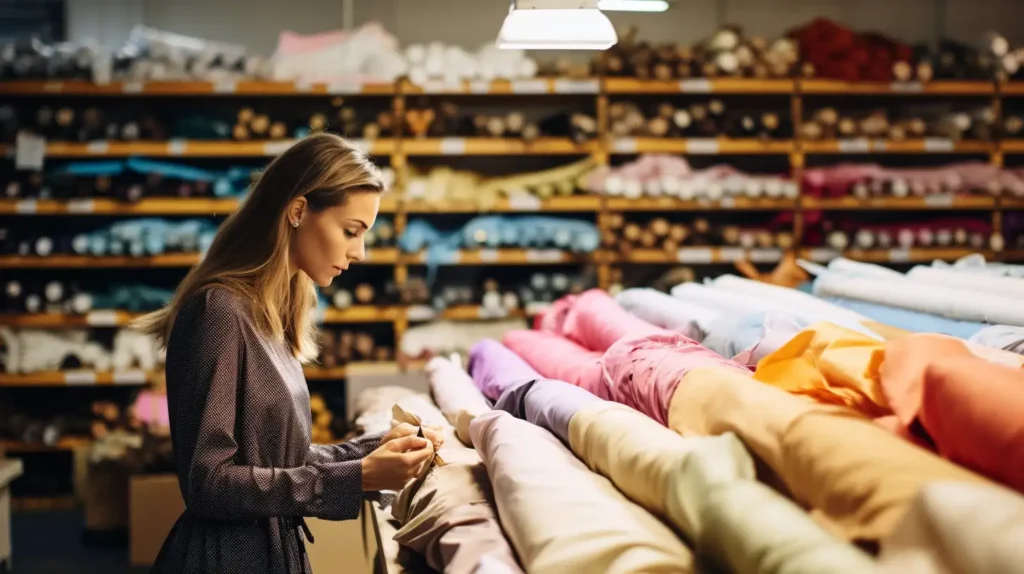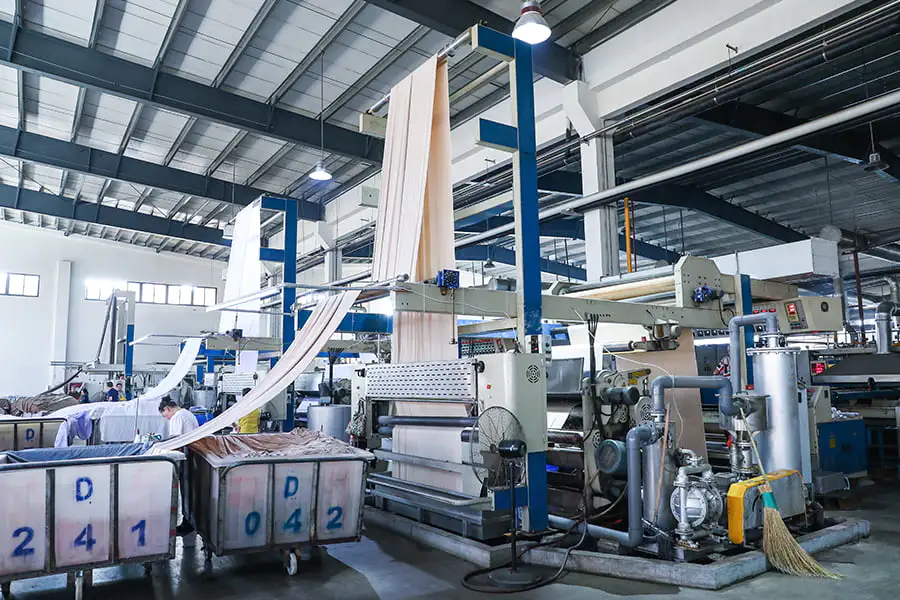As a fabric sourcing agency, we understand that finding the right fabric for your product can be a daunting task. With so many different types of fabrics and suppliers to choose from, it can be overwhelming to know where to start. In this guide, we will take you through the step-by-step process of fabric sourcing, with a focus on sourcing fabrics from China.
Step 1: Understanding Your Fabric Needs

Before you start looking for fabrics, it’s important to understand your fabric needs. This includes factors such as the type of product you are making, the desired qualities of the fabric (e.g. stretch, breathability, durability), the color and pattern you need, and your budget.
To help you understand your fabric needs, ask yourself the following questions:
- What type of product am I making?
- What qualities do I need in my fabric (e.g. stretch, breathability, durability)?
- What colors and patterns do I need?
- What is my budget for fabric?
Once you have a clear understanding of your fabric needs, you can start looking for fabrics that meet those requirements.
Step 2: Researching Fabric Suppliers
When it comes to sourcing fabrics from China, there are a vast number of suppliers to choose from. To find the right supplier for your needs, you’ll need to do some research.
1. Attending Industry Trade Shows

One of the best ways to find reliable fabric suppliers in China is by attending trade shows. China has many textile trade shows throughout the year where you can meet suppliers in person and see their products. Some of the most popular textile trade shows in China include Intertextile Shanghai, Canton Fair, and Yarn Expo. These trade shows offer a great opportunity to network with suppliers, get a feel for the market, and learn about the latest trends.
2. Utilizing Online Sourcing Platforms
Another way to find reliable fabric suppliers in China is by using online sourcing platforms like Alibaba, Global Sources, ja Made-in-China.com. These platforms have a large number of suppliers listed, and you can easily search for specific types of fabrics. Be sure to read reviews and check supplier ratings before making any purchases. You can also request samples from multiple suppliers to compare quality and pricing.
3. Partnering with a Professional Fabric Sourcing Agent

If you want to efficiently find the ideal fabric supplier, working with a professional sourcing agent is an excellent choice. A sourcing agent like ENATRENDY, with extensive local resources and expertise in China’s textile industry, can provide the following services:
- Supplier Selection: Identify suitable and reliable suppliers based on your specific needs.
- Price Negotiation: Leverage local networks and industry expertise to secure competitive pricing.
- On-Site Inspections: The agent can visit supplier factories on your behalf to review production processes and working conditions, ensuring quality standards are met.
- Sample Collection and Evaluation: Assist in collecting, evaluating, and organizing samples from multiple suppliers, saving you time and effort.
- Support for Small Orders: If your order volume is small, agents can often find suppliers willing to accommodate smaller quantities, which might be challenging to secure on your own.
By partnering with a sourcing agent, you can save significant time and effort while minimizing communication and quality risks during the supplier search process.
Step 3: Evaluating Fabric Samples

Once you have a list of potential fabric suppliers, it’s time to evaluate their samples. Most suppliers will offer to send you fabric samples so you can test the quality and see if it meets your requirements.
When evaluating fabric samples, consider the following:
- Does the fabric meet your desired qualities?
- Are the colors and patterns what you need?
- Is the fabric comfortable to touch and wear?
- Does the fabric meet your budget requirements?
Step 4: Factory Inspection

A factory inspection typically involves a visit to the supplier’s facility to examine their manufacturing process, equipment, and working conditions. The inspection team should consist of experts in production management, quality control, and technical compliance to ensure a comprehensive review.
During the inspection, the team should verify the supplier’s compliance with local laws and regulations, including labor standards, environmental protection, and workplace safety. They should also evaluate the supplier’s production capacity, quality control measures, and management systems.
The results of the factory inspection can help you identify any potential risks or issues with the supplier and decide whether to move forward with the partnership. If the inspection reveals significant problems or non-compliance with your standards, it may be necessary to find a different supplier.
Step 5: Negotiating with Fabric Suppliers

After you’ve evaluated the fabric samples and selected a few suppliers that meet your needs, it’s time to negotiate. Negotiating can help you get the best price and terms for your fabric orders.
When negotiating with fabric suppliers, consider the following:
- Quantity: The more fabric you order, the better the price you can negotiate.
- Payment terms: Negotiate payment terms that work for both parties.
- Delivery time: Make sure the supplier can deliver the fabric within your desired timeline.
- Quality assurance: Discuss quality control measures to ensure the fabric meets your standards.
Step 6: Placing Fabric Orders
Once you’ve negotiated with the fabric suppliers and agreed on the terms, it’s time to place your fabric orders. Make sure you have a clear understanding of the delivery timeline, payment terms, and quality control measures before placing your order.

When placing your fabric orders, consider the following:
- Place a sample order first: If you’re working with a new supplier, it’s a good idea to place a small sample order first to test the quality and reliability of the supplier.
- Use a purchase order: A purchase order is a legal document that outlines the terms and conditions of the transaction. Make sure to use a purchase order to protect your interests.
- Follow up on delivery: Stay in touch with the supplier to ensure that the fabric is delivered on time.
Step 7: Quality Control and Inspection

Quality control is an essential part of the fabric sourcing process. You’ll need to inspect the fabric to ensure that it meets your requirements
Ensuring quality control and product inspections is crucial in the fabric sourcing process. Quality issues can lead to significant problems such as product recalls, returns, and negative brand reputation. It’s important to conduct inspections at various stages of production to ensure the final product meets the required standards.
The inspection process can include checking the fabric quality, color, paino, leveys, and design. Inspections can be conducted at the fabric mill, during production, or before shipping. Working with a sourcing agent who has experience in quality control can help to minimize the risk of receiving substandard fabrics.
Step 8: Logistics and shipping

After the fabrics are sourced and inspected, the logistics and shipping process comes into play. Sourcing agents can help you to find the best shipping options based on your budget and timeline. They can also help with customs clearance, documentation, and other logistical requirements.
When choosing a shipping method, it’s important to consider the weight and volume of the fabrics, as well as the shipping time and cost. Air freight is faster but more expensive, while sea freight is slower but more cost-effective for larger quantities.
Step 9: Ongoing supplier management
Sourcing fabrics is not a one-time process, and it’s important to establish and maintain relationships with suppliers for future orders. Sourcing agents can help you to manage these relationships by providing ongoing support, regular communication, and addressing any issues that arise.
Managing supplier relationships can help to ensure consistent quality, competitive pricing, and reliable lead times. It can also help to identify opportunities for cost savings, process improvements, and new product development.
Bottom Line
Sourcing fabrics can be a complex process that requires significant time, effort, and expertise. Working with a fabric sourcing agent can help to simplify this process and provide you with access to a wide range of suppliers, quality control, negotiation, and logistics support.
By following the steps outlined in this guide, you can ensure that your fabric sourcing process is efficient, effective, and meets your business needs and goals. If you’re looking for a reliable fabric sourcing partner, contact us to learn more about our services and how we can help your business succeed.



